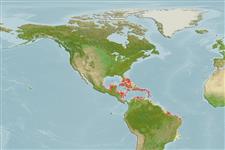Environment: milieu / climate zone / depth range / distribution range
Ecologia
marino associati a barriera corallina; distribuzione batimetrica 0 - 5 m (Ref. 9710). Subtropical
Western Atlantic: southern Florida (USA), Bahamas, and Yucatan, Mexico to northern South America.
Size / Peso / Age
Maturity: Lm ? range ? - ? cm
Max length : 6.0 cm TL maschio/sesso non determinato; (Ref. 7251)
Spine dorsali (totale) : 20 - 21; Raggi dorsali molli (totale) : 11; Spine anali: 2; Raggi anali molli: 19 - 20. Body with dark bars; first two bars connected to form an H, last two bars remote from first (Ref. 26938).
Inhabits limestone rock, rubble and coral reef areas. Usually near sea urchins (Ref. 9710). Feeds on amphipods and copepods (Ref. 13628).
Life cycle and mating behavior
Maturities | Riproduzione | Spawnings | Egg(s) | Fecundities | Larve
Robins, C.R. and G.C. Ray, 1986. A field guide to Atlantic coast fishes of North America. Houghton Mifflin Company, Boston, U.S.A. 354 p. (Ref. 7251)
IUCN Red List Status (Ref. 130435)
Threat to humans
Harmless
Human uses
Strumenti
Special reports
Download XML
Fonti Internet
Estimates based on models
Preferred temperature (Ref.
123201): 26.4 - 28.2, mean 27.5 °C (based on 541 cells).
Phylogenetic diversity index (Ref.
82804): PD
50 = 0.5000 [Uniqueness, from 0.5 = low to 2.0 = high].
Bayesian length-weight: a=0.00912 (0.00399 - 0.02083), b=3.06 (2.87 - 3.25), in cm total length, based on LWR estimates for this (Sub)family-body shape (Ref.
93245).
Trophic level (Ref.
69278): 3.2 ±0.36 se; based on food items.
Fishing Vulnerability (Ref.
59153): Low vulnerability (10 of 100).
Nutrients (Ref.
124155): Calcium = 99.3 [37.7, 233.6] mg/100g; Iron = 0.876 [0.441, 1.690] mg/100g; Protein = 19.3 [18.1, 20.5] %; Omega3 = 0.211 [0.104, 0.435] g/100g; Selenium = 6.41 [2.58, 15.63] μg/100g; VitaminA = 145 [39, 563] μg/100g; Zinc = 1.76 [1.02, 2.88] mg/100g (wet weight);
